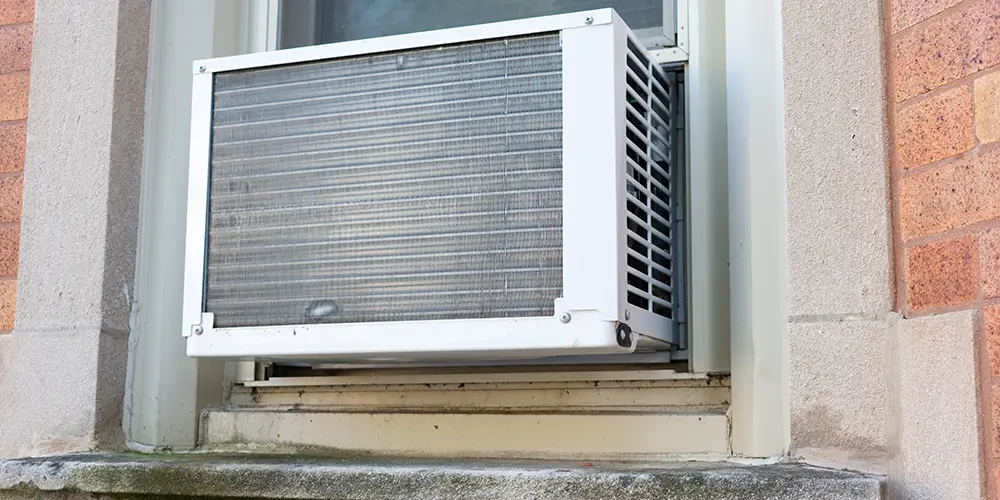Condensation dripping off a wall or window air conditioner is nothing unusual.
We’re used to seeing it outside — a sign the AC unit is doing its job! But what happens when the dripping moves inside, onto the carpet or end table? It’s not so acceptable anymore.
Is it normal? Or is it a symptom of something seriously wrong with the AC unit?
Relax — the air conditioner is fine, in all probability. But you may have to make an adjustment or two.
1. Tilt the Air Conditioner from Front to Back
Wall and window AC units drip water out of the back due to condensation from the evaporator coils. They should never drip out the front.
So what the hey?
- Did elves shift the evaporator coils in the dead of night?
- Is the unit on the fritz?
- Is there a problem with the installation?
In this multiple-choice question, #3 is the correct answer. The AC unit must tilt downward slightly from front to back to drain as designed. A too-flat installation, or worse, one that leans slightly forward, invites trouble.
While checking the angle, adjust the unit’s fit and seal it tight to prevent warm air from entering the room. Warm air decreases efficiency. Less recognized is the fact that it brings condensation, especially in humid climates. Drip, drip, drip.
2. Clear the Hole in the Drip Pan
Most wall and window air conditioners have drip pans. As the name implies, drip pans deal with drips; more precisely, they collect condensation from the unit and direct it through a rear drain hole onto the ground.
Like the drains in your gutter, this drain hole is prone to clogs. Check the drip pan periodically to clear any debris. Consider drilling one in the rear corner if your drip pan lacks a drain hole. Which rear corner? That’s entirely up to you.
3. Use a Pan Tablet
A pan tablet is a tablet-shaped cleaning agent to remove dirt, grime, and other impurities from the drip pan of a wall or window air conditioner. It also prevents mold and condensate buildup.
You’ll place the tablet in the water-filled AC pan until it dissolves and breaks down debris, allowing it to be rinsed away.
Pan tablets are sold at most home improvement stores or online retailers. They’re inexpensive, easy to use, and a great way to keep the AC unit working correctly.
4. Clean the Air Conditioner
Sometimes, the only solution for a leaking air conditioner is to clean it thoroughly.
Dust build-up on the coils can cause water to form and drip. To prevent this, remove the side covers — be sure to unplug the AC first — and clean the coils with a soft brush or cloth. Don’t use harsh chemicals!
Check for leaves, sticks, and debris blocking or impeding airflow.
Follow your AC’s owner manual for specific cleaning instructions. If you need help, call a qualified HVAC technician.
5. If All Else Fails, Hire an AC Repair Pro
The unit may still leak water inside, no matter how hard you try. When it does, it’s time for a professional repair.
Air conditioners are complex systems with intricate components. Even if you know your way around an AC unit, it’s best to leave repairs to the professionals.
Hiring a technician with years of experience will guarantee the job is done correctly and quickly — so you can stop worrying about water dripping from your AC!
Need professional help? Contact Orange Coast Plumbing for any AC repair, including wall and window units.
FAQs: Leaking Window Air Conditioner
Q: Why is my wall or window air conditioner leaking water inside?
It’s usually a sign of poor installation, a clogged drain hole, or dirty coils.
Q: How do I fix a leaking wall or window AC unit?
Tilt the unit from front to back, clear the drain hole in the drip pan, use a pan tablet, clean the air conditioner, or hire a professional repair technician.
Q: Can I prevent my air conditioner from leaking water inside?
Yes! Regularly check and maintain your AC unit by tilting it correctly and cleaning it as needed. Consider using a pan tablet to prevent buildup in the drip pan.
Q: How can I tell if my wall or window air conditioner is tilted correctly?
Use a level to check the angle of your AC unit. Additionally, you should ensure the unit is securely fitted and sealed to prevent warm air from entering.
Q: Can a leaking wall or window air conditioner cause damage to my home?
Water damage from a leaking AC unit can lead to mold growth and structural damage. It’s important to address the issue as soon as possible.
Q: Can I use homemade solutions instead of pan tablets for cleaning my AC unit?
We don’t recommend this. Homemade solutions may contain harsh chemicals that could damage the unit. Stick to using pan tablets or consult a professional for safe cleaning options.


